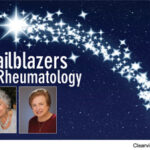
Dragon Images/shutterstock.com
WASHINGTON, D.C.—Paulette Hahn, MD, associate professor of medicine specializing in rheumatology at the University of Florida (UF), said she once treated a patient named Monica, a UF undergraduate who had severe inflammatory muscle disease and severe lung disease.
The patient’s disease was under control for the time being, but Monica knew she could take a turn for the worse at any time. For that reason, she was sure to stay ahead in her coursework. Dr. Hahn got to know Monica well and came to admire her “incredible joy for life.”
When Monica came in for a visit one day, she told Dr. Hahn that she’d gone on a tubing trip, taking her oxygen tank with her as she floated down a river. Going by the book, this might have come as horrifying news to Dr. Hahn, and indeed, she said her reaction was to think, What in the world? and worry about what could have gone wrong.
But she kept that reaction to herself.
“Out loud, I said, ‘You go for it; that is fantastic.’” She knew Monica as a person, not just as a patient, and knew how important the trip must have been for her. Monica died before graduating, but Dr. Hahn advocated for a diploma, which was given to her family.
Treat the Whole Person
The role of the humanities—getting to know and treating a person as a whole, rather than just with medication and treatment strategies—should be more prominent in medicine, said Dr. Hahn during the ARHP keynote session at the 2016 ACR/ARHP Annual Meeting. Combining humanity with clinical care results in more compassionate and more effective patient care and more fulfilling work for physicians, Dr. Hahn said.
“The humanities are truly concerned about the science of the human,” she said. “It helps us engage; it helps us think; it helps us ask questions and be curious.”
Melding humanities and medicine, or health humanities (a term that Dr. Hahn prefers), involves four main factors: compassion, curiosity, collaboration and creativity.
These factors can be particularly useful in rheumatology, a field that often requires a deeper bond between patients and physicians. Dr. Hahn reminded the audience that rheumatologists often focus on the hands—which are so important to human connection—and that rheumatologists often need to “see things that others may not see, even when they look.”
Rather than thinking strictly medically, she encouraged the audience to think of their care as part of the health humanities, which provides a kind of universal language for inter-professionalism and collaboration. Rather than “patient-centered” care, she said, it would be better to consider the patient as having a seat at the table, so to speak, participating in a collaborative care process with the physician.
The Importance of Play
Dr. Hahn also emphasized the idea that play shouldn’t be seen as the opposite of work.
“I suspect some of you are busy, [in] fast-paced [practices] and juggling lots of different things, and we work, and we think that there’s a separation of work and play. I’d like to propose that we add play to our work,” Dr. Hahn said. “Some of my greatest moments have involved colleagues who’ve incorporated play into their workday.
“It helps us be resilient,” she said. “It helps us be creative. It helps us with this intellectual creativity,” she added. “It also helps us be a part of a community, which I think everyone in this room is.”
As difficult as it might be to hit the brakes during a chaotic workday, breaks are vital to being the best doctor you can be, Dr. Hahn added. “It helps those in the very fast-paced world of health and medicine to stop to pause to truly look at patients to really understand and listen,” she said.
Dr. Hahn said she teaches a fourth-year medical student elective course at UF called the “Art of Advanced Physical Diagnosis and Clinical Reasoning,” which includes spending time at an art museum. “The bedside requires deep attention, deep listening and deep observation, and that’s what we try to get across,” she said.
Dr. Hahn said that if she thinks a patient would benefit from writing, she hands them a blank piece of paper and a pen and asks them to write down their thoughts. They can even draw if they want to, she said. This way, Dr. Hahn said she gets a sense of patients’ struggles, desires and fears.
‘Some of my greatest moments have involved colleagues who’ve incorporated play into their workday.’ —Dr. Hahn
One patient wrote about the frustrations of “not having my family together” and “being blocked by physical restrictions” and “feeling unmotivated.” On the other hand, they wrote, they were still grateful for their children and “my furry friends” and “that I’m alive.”
Another wrote about things they’d like to do. “Be happy, hear less complaining and negativity. Exercise. Read more. Be more relaxed. Pray. Take care of me. Don’t rush. Breathe.”
Dr. Hahn said she still benefits from the lessons she learned from Monica, the UF student. “She taught me how to slow down,” she said. “She gave me this quiet sense of urgency in a way that was a calming urgency, one to truly experience every single, solitary day to its fullest and not worry about the things you can’t do, but take on the things you can do, the things we help patients do on a regular basis.”
Audience Reactions
After the talk, audience member David Yu, MD, emeritus professor of medicine at University of California Los Angeles, said he asks patients what their “most recent stressor” is, and he often finds that it’s an issue in their personal life and not something medical. Sometimes, he said, “I just stop talking” as an invitation for his patient to talk.
“‘You are a very different doctor,’” he said patients have told him. “‘You listen.’”
Fellow meeting attendee Jillian Rose, LCSW, assistant director for community engagement, diversity and research at the Hospital for Special Surgery in New York, said it’s important to understand the values of patients, not just the values of the healthcare field.
“Our patient wants dignity and respect. So no matter what’s happening in the context of our busy-ness, dignity and respect are something that none of us opt out of,” Ms. Rose said.
Another audience member said that although she agrees that listening more is a key to better patient care, taking the time isn’t something that’s modeled well in graduate medical education and wondered “how to break down that wall.”
Dr. Hahn said giving a patient the blank piece of paper she talked about previously can help with this: She can leave to see another patient, and when she returns, Dr. Hahn said she and the patient are often armed with more information that they can use as care moves forward.
Also, pausing before walking in to see a patient or walking into the hospital can help keep you in the moment, she said.
Still, Dr. Hahn acknowledged that making time can be a challenge. “It’s a work in progress, even for myself.”
Thomas R. Collins is a freelance writer living in South Florida.
